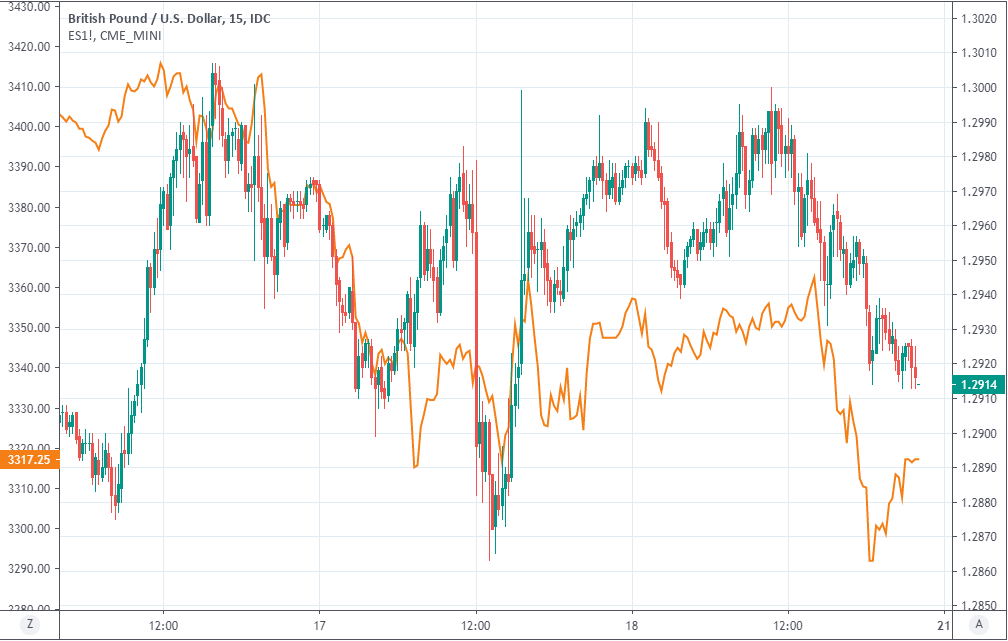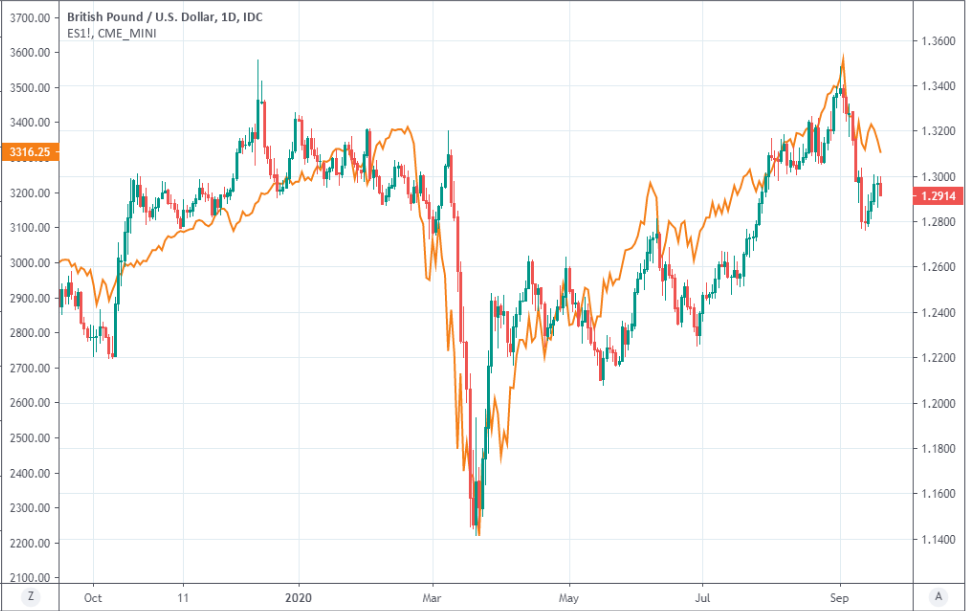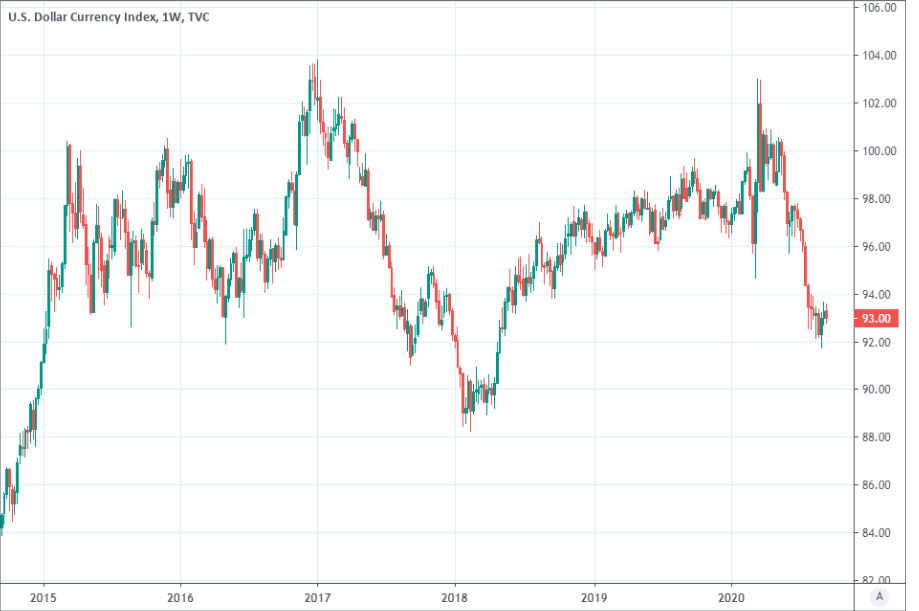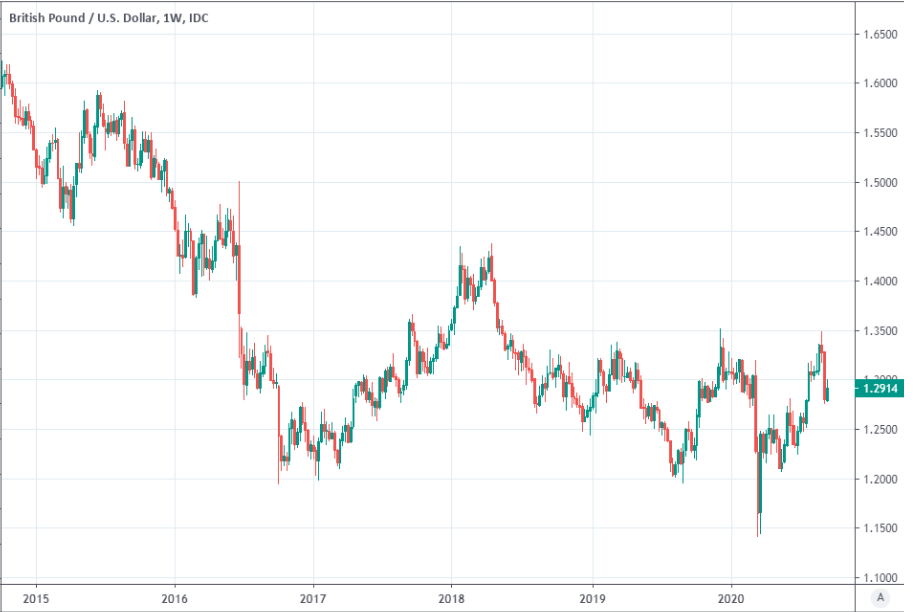Pound-Dollar Week Ahead Forecast: At Risk of Retreat to 1.27 as Virus and Brexit Fears Dominate
- Written by: James Skinner
- GBP/USD at risk of further declines as coronavirus threat returns.
- Lockdown looms as Brexit risks rise, USD stirs & stocks wobble.
- GBP/USD liable for retreat back toward 1.27 over coming week.

Image © Adobe Images
- GBP/USD spot rate at time of writing: 1.2909
- Bank transfer rate (indicative guide): 1.2461-1.2552
- FX specialist providers (indicative guide): 1.2727-1.2805
- More information on FX specialist rates here
The Pound-to-Dollar exchange rate rebounded last week but risks unravelling anew in the coming days as the government’s coronavirus response threatens the economic recovery and an EU trade agreement remains elusive, although much also depends on whether stock markets recover their poise.
Sterling went from hero to zero Friday, eroding handsome gains for the week against most major rivals including the Dollar after the government announced new restrictions on freedoms in the North of England, citing a second wave of coronavirus infections that is yet to show up in the hospitals and morgues.
The human cost of the virus has continued to decline more than one month after the second wave began to build in mid-August, yet Prime Minister Boris Johnson and his ministers have tightened restrictions in a number of areas in the North and even gone so far as to threaten another national ‘lockdown.’
Such a course of action could severely hamper the economic recovery at a time when Brexit risks are elevated and the market is already turning bearish in its outlook for Sterling due to the possible economic impact of a ‘no deal’ exit from the transition period after year-end.
The two sides have continued to talk but in the absence of compromises on European demands in the trade talks and a climbdown from London over the Internal Market Bill, 'no deal' Brexit risk could remain a weight around the ankles of Sterling. However, virus fear, investor appetite risk and related demand for the Dollar are also key influences.
"The government continues to press ahead with its attempt to pass the Internal Market Bill. Its aims remain hard to decipher and the episode has clearly damaged trust between the UK and EU. But the path to a trade deal remains open, should both sides choose to follow it," says Andrew Goodwin, chief UK economist at Oxford Economics.
Above: GBP/USD at 15-minute intervals alongside S&P 500 futures (orange line, left axis).
“GBPUSD remains capped at its falling 13 -day exponential average and with the market still below the high of the recent large bearish “outside day” at 1.3035,” says David Sneddon, head of technical analysis at Credit Suisse. “We continue to view strength as a corrective rebound ahead of the risk turning lower...An overshoot to the “measured top objective” at 1.2655 should be allowed for, but we would look for a floor here.”
Sneddon sees technical resistance keeping Sterling below 1.3038 and looks for GBP/USD to retreat back toward 1.27 this week as it completes a topping pattern on the charts, although other analysts have gone further and are looking for a fall back to late May lows around 1.22 in the next one-to-three weeks.
“GBP/USD’s bounce from the 200 day ma at 1.2729 has been tepid and so far has remained capped by the 20 day ma at 1.3101. While below here we will maintain a negative bias,” says Karen Jones, head of technical analysis for currencies, commodities and bonds at Commerzbank, who sold the Pound-to-Dollar rate just below 1.30 last week. “Loss of 1.2690 Fibo support should be enough to trigger a slide to 1.2445 and then 1.2250/00.”
Sterling faces a toxic cocktail of ‘no deal’ Brexit risk combined with a ‘lockdown’ threat and pre-election Dollar strength that could all weigh on the Pound-to-Dollar rate in the days and weeks ahead. Brexit talks continue this week and will be a key focus along with government statements about the coronavirus, although of equal importance is the trajectory of stock markets and investor appetite for risk assets as well as currencies.
Above: Pound-to-Dollar rate shown at daily intervals alongside S&P 500 futures (orange line, left axis).
“The pull-back in global equities over the past couple of days will be short-lived unless the rise in new cases starts to weigh more heavily on the economy,” says Simona Gambarini at Capital Economics. “The increase in coronavirus cases in Europe has not been accompanied by a sharp rise in deaths. As a result, most governments have not yet reintroduced national lockdowns, although there are suggestions that the UK is considering re-imposing one."
Stocks faltered last week and the Dollar rose even before the Commerce Department said Friday it would bar two Chinese social media networks from the U.S., indicating that mistrust of and hostility toward the world’s second largest economy remain alive and well in Washington. The announcement exacerbated declines in stocks and sent the Chinese Yuan lower, and the Pound-to-Dollar rate has a strong positive correlation with both so could tumble again if the two remain under pressure this week.
"President Donald Trump has been gaining in the polls and we expect this to prop up the currency in the coming weeks," says Valentin Marinov, head of FX strategy at Credit Agricole CIB. "First is the expectation that a closely contested election could weigh on risk sentiment, fuel FX volatility and boost the USD, similar to 2000. Second, a Trump victory could revive fears of new trade tariffs and thus weigh on the currencies of the US’ main trading partners."
The Dollar has fallen heavily in recent months, enabling the Pound-to-Dollar rate to rise even as the atmosphere in the Brexit trade talks soured, but the U.S. currency has a long-established tendency to rise ahead of presidential elections as uncertainty about the policy outlook builds.
But with tensions between the U.S. and China rising again and the election now less than six-weeks away, the going could be about to get even tougher for stock markets, the Chinese Yuan and the Pound-to-Dollar rate.
Above: Dollar Index shown at weekly intervals, erasing Trump presidency from the charts.
With Brexit and coronavirus coronavirus restrictions aside the market’s focus will be on a number of speeches from Bank of England Governor Andrew Bailey and Federal Reserve Chairman Jerome Powell. Bailey’s first speech is at 08:30 on Tuesday and the second at 15:00 Thursday while Powell will speak between 15:00 and 15:30 on each day of the week up until Friday.
“There is no top-tier data in the week ahead so the focus will be on central bank speeches. RBA Deputy Governor Debelle, BoE Governor Bailey and Fed Chair Powell will all speak next week. Volatility is most likely in GBP where UK-EU trade risks remain elevated and given our view that risks have barely been priced. Michel Barnier stated yesterday that the coming days will be crucial,” says Derek Halpenny, head of research, global markets EMEA and international securities at MUFG. "The FOMC outcome was broadly as we expected. The DOTs was the main tool of communication. However, the lack of urgency on show to lift inflation we believe will limit the appetite for renewed selling of the dollar. We remain in consolidation mode with a EUR/USD range of 1.1600-1.2000 set to hold over the coming months."
Sterling will listen closely to Bailey after the BoE said last week that it’s prepared to adopt negative interest rates. The bank also gave little indication about whether and when its quantitative easing programme will be topped up. However, the Fed’s Powell is a threat to the Dollar and upside risk to the Pound given that investors were disappointed last Wednesday by a lack of additional policy support from the Fed and perception that America’s central bankers were not as concerned about the outlook as many expected.
“We see sterling following EURUSD for the most part, as euro traders jostle around their 1.1850 option expiry,” says Eric Bregar, head of FX strategy at Exchange Bank of Canada. “The options market looks like it has completely lost interest in EURUSD upside if we look at the continued erosion for 1-month call premiums vis a vis the cost for 1-month puts (risk reversals). The speculative funds at CME remain net long this market.”
Above: Pound-to-Dollar rate shown at weekly intervals.









